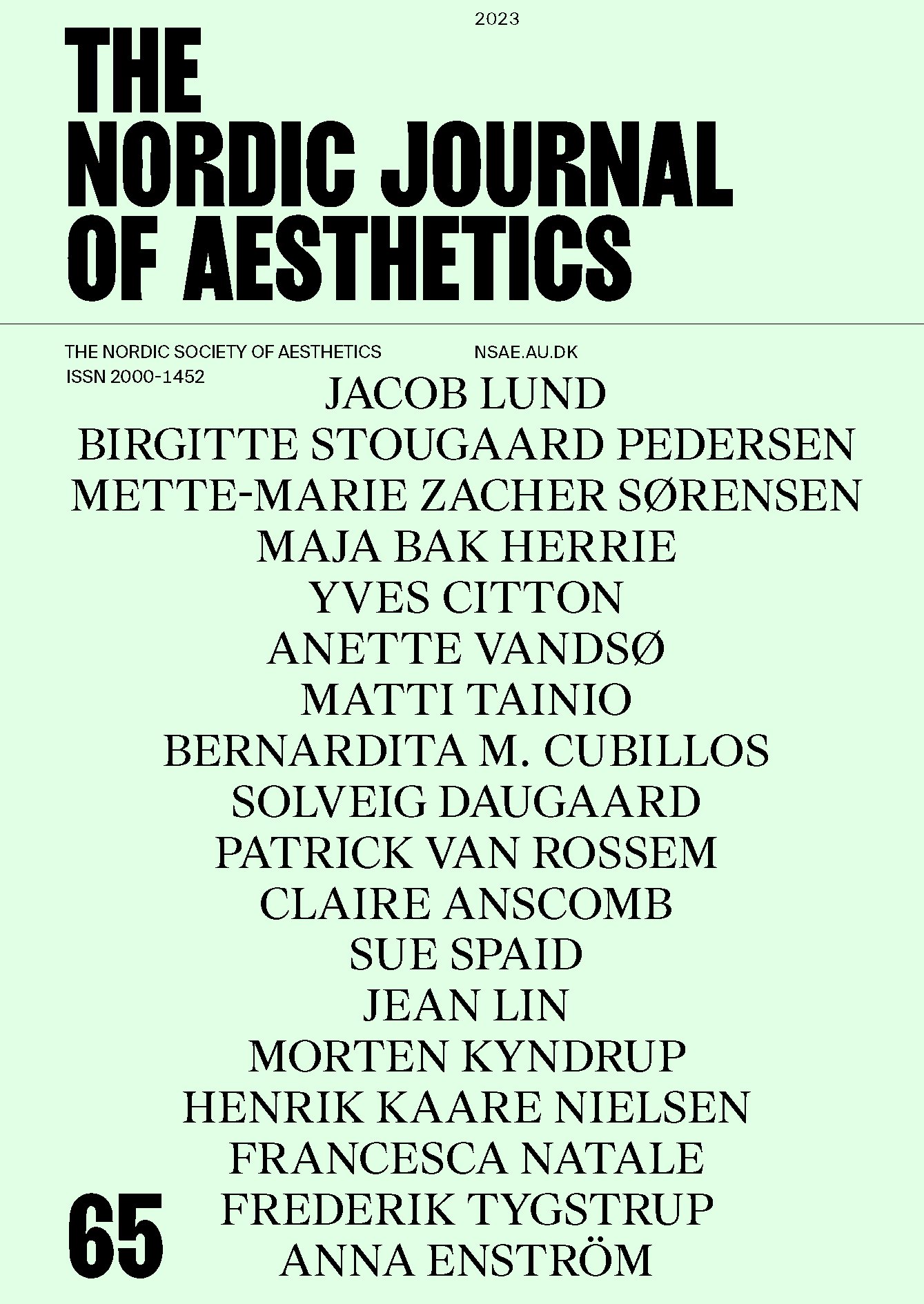Your Tongue Here (Or Not): On Imagining Whether To Take a Bite (Or Not)
DOI:
https://doi.org/10.7146/nja.v32i65.140201Keywords:
Attention, Disgust, Deception, Exhibition, Emotion, ImaginationAbstract
Inspired by recent visits to the Disgusting Food Museum (DFM) in Mälmo, SE and “FOOD: Bigger than Your Plate” (2019) at the Victoria & Albert in London, UK, this article explores the saliency of “disgust” given its role in the “attention economy,” hipster allure and emotional encoding. Initially appalled by the DFM’s demonizing national delicacies as disgusting, the author soon realised that doing so has a “silver lining” in terms of attention. One aspect that remains under-explored is the connection between imagination and attention. The relationship between taste and disgust grants us a vehicle for working this out, since human beings are wired for disgust, yet what disgusts is learnt. Unlike basic emotions for which we have salience and/or memories, we deploy our imagination to anticipate disgust. To defeat disgust’s alarmist ploys, “food adventurers” must block their imagination. “Disgusting food” not only grabs people’s attention, but it tends to deceive.
References
Immanuel Kant, Critique of Pure Judgement (New York: Hafner Press, 1951).
Spaid, Sue, “Value Disgust: Appreciating Stench’s Role in Attention, Deception and Retention,” Rivista de Estetica, no. 78 (March 2021): 74–94.
Barry Smith 2017: 794. 2017, “Human Olfaction, Crossmodal Perception and Consciousness,” Chemical Senses, 42, no. 9 (September 2017): 794, https://doi.org/10.1093/chemse/bjx061.
Immanuel Kant, Anthropology from a Pragmatic Point of View (Cambridge: Cambridge University Press, 2006), 50–51.
Sam West, https://disgustingfoodmuseum.com/.
Rachel Herz, That’s Disgusting: Unraveling the Mysteries of Repulsion (New York: W.W. Norton & Company, Inc., 2012).
Bobby Duffy, The Perils of Perception: Why We’re Wrong About Nearly Everything, (London: Atlantic Books, 2019).
L. G. Birch, “A Study of Certain Methods of Distracting the Attention: II. Distraction by Odors,” The American Journal of Psychology, 9, no. 1 (October 1897): https://doi.org/10.2307/1411473.
Drugs and Lactation Database (LactMed) [Internet]. Bethesda (MD): National Library of Medicine (US); 2006-.Garlic. [Updated 2021 Feb 15]. https://www.ncbi.nlm.nih.gov/books/NBK501782/.
Laura Alho et. al., “Nosewitness Identification: Effects of Lineup Size and Retention Interval,” Frontiers of Psychology, 7(2016): https://doi.org/10.3389/fpsyg.2016.00713.
Stina Kærnekull et. al., “Long-Term Memory for Odors: Influences of Familiarity and Identification Days,” Chemical Senses, 40, no. 4 (May 2015) https://doi.org/10.1093/chemse/bjv003.
Alison George, “The Yuck Factor: The Surprising Power of Disgust,” New Scientist (14 July).
E.A. Krusemark et. al., “When the Sense of Smell Meets Emotion: Anxiety-State-Dependent Olfactory Processing and Neural Circuitry Adaption,” Journal of Neuroscience, 33, no. 39 (2013), https://doi.org/10.1523/JNEUROSCI.1835-13.2013
Adrian Furnham, The New Psychology of Money (East Sussex: Routledge, 2014), 251, https://doi.org/10.4324/9780203506011.
Martha Nussbaum, Hiding from Humanity: Disgust, Shame and the Law (Princeton: Princeton University Press, 2004).
Downloads
Published
How to Cite
Issue
Section
License
Copyright (c) 2023 Sue Spaid

This work is licensed under a Creative Commons Attribution 4.0 International License.
Authors who publish with this journal agree to the following terms:
- Authors retain copyright and grant the journal right of first publication with the work simultaneously licensed under a Creative Commons Attribution License that allows others to share the work with an acknowledgement of the work's authorship and initial publication in this journal.
- Authors are able to enter into separate, additional contractual arrangements for the non-exclusive distribution of the journal's published version of the work (e.g., post it to an institutional repository or publish it in a book), with an acknowledgement of its initial publication in this journal.
- Authors are permitted and encouraged to post their work online (e.g., in institutional repositories or on their website) prior to and during the submission process, as it can lead to productive exchanges, as well as earlier and greater citation of published work (See The Effect of Open Access).




